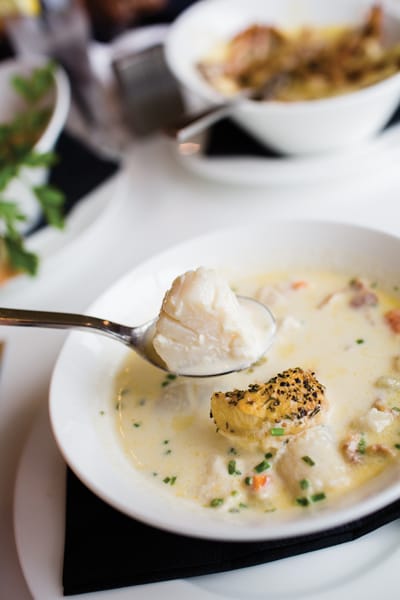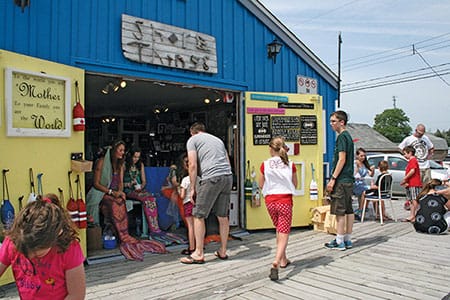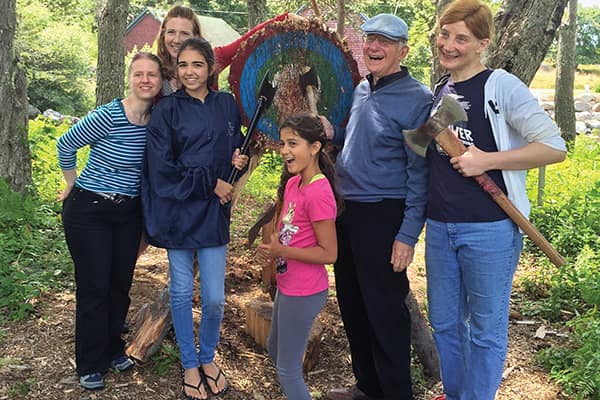Cabot Links sets a new standard for golf—and après-golf
It started in March 2004, with the chance pairing at a Toronto function of Ben Cowan-Dewar—a man with dreams of someday building a world class links golf course—and Rodney MacDonald, then Nova Scotia Minister of Tourism, and an Inverness, NS, native.
For years, the abandoned site of the long-closed Inverness coal mines, which ran alongside Inverness Beach, in Nova Scotia, had been recognized as the site for a potential links golf course (see “What is a ‘Links’ Course?” at left). At their meeting, MacDonald convinced a somewhat skeptical Cowan-Dewar to visit the site—and from the moment he saw it, Cowan-Dewar knew he had found the perfect location.
He’s a man who knows his golf courses, particularly the great ones. As a member of a panel that selects the top 100 courses in the world for Golf magazine, Cowan-Dewar has played most of them. His preference is for true links courses, the most famous of which is the Old Course in St. Andrews, Scotland. There are fewer than 250 worldwide—and until Cabot Links, none in Canada. Most courses that use the word “links” in their name—including the venerable Highlands Links in nearby Ingonish—are not actually links courses. The opportunity to acquire a piece of land upon which a true links course could be built was too good to pass up.

If you build it
It was going to be an expensive proposition, though. The idea of spending millions of dollars to build a course—in a location that most thought was too remote to attract the type of clientele necessary to make it financially viable—had a lot of naysayers.
Cowan-Dewar knew differently; it had been done before, and quite recently. In 1999, Mike Keiser had opened Bandon Dunes on the rugged shores of Oregon, in an area even more remote from large population centres than Inverness. Within a decade, Bandon Dunes was being hailed as one of the top courses in North America. Four other courses followed in rapid succession, and today, three of the top 10 courses open to the public in the US are at Bandon Dunes. It was a classic case of “if you build it, they will come.”
Cowan-Dewar brought in Canadian golf architect Rod Whitman—a protege of legendary designers Pete Dye and Bill Coore—and gave him a free hand. He invited Mike Keiser to partner with him; they hired Brian MacKay-Lyons—perhaps Nova Scotia’s most celebrated architect and a specialist in seaside architecture—to design the clubhouse. After a test run of 10 holes in 2011, the dream became reality when Cabot Links opened its full 18 holes in the summer of 2012.
It became an immediate sensation in the golf world. The opening of a new true links course anywhere in the world is such a rare event that it drew golf writers from four continents to play and offer their verdicts. The consensus was that it is a masterpiece that will quickly take its place as one of the best courses in Canada, if not the world.
A boon to Cape Breton
Just as the course was opened, a 48-unit accommodations building—Cabot Links Lodge, designed by another award-winning Nova Scotia architect, Susan Fitzgerald—was unveiled. Fitzgerald has created an ultra-modern complex where every room has a stunning ocean view.
Husband and wife team John Haines and Tracy Wallace were brought in to oversee the food and beverage service (Haines has CCC—Certified Chef de Cuisine—credentials from the Canadian Culinary Institute). As its name suggests, Panorama Restaurant pro-vides not only gourmet cuisine, but a million-dollar view, which only serves to enhance the dining experience. The Cabot Bar offers a selection of more than 40 whiskies, including three from the nearby Glenora Distillery. Even without the golf course, this would be a destination resort.
Cabot Links has proven to be a boon to all of Cape Breton. Aside from the many construction jobs it created, it employs 125 people from late spring to mid-November. The operation provides job opportunities for high school and university students, who might otherwise leave the area to seek summer employment. Last year, 50 people were employed as caddies—and received golf privileges in the bargain.
Beneficiaries
Perhaps the greatest beneficiaries of Cabot Links will be the other great golf courses in Cape Breton. For the first time, a major golf travel provider—Perry Golf—has added Cape Breton to its list of worldwide destinations. The company now offers six different itineraries, which include all of the other five resort courses on the Island, as well as extensions to Fox Harb’r and Glen Arbour on Nova Scotia’s mainland.
Not one to sit on his laurels, Cowan-Dewar has commissioned one of the world’s most sought-after design teams, Bill Coore and two-timer Masters champion Ben Crenshaw to build Cabot Cliffs on a nearby property that features terrain similar to that found on the Monterey Peninsula, in California. It is slated to open in 2015.
Cabot’s culinary groove by Shelley Cameron-McCarron
The Cape Breton Seafood Chowder is gone. All of it—the plump morsels of haddock; the lobster; the scallops. And with his last soul-stirring spoonful, my husband leans in close at our table overlooking dreamy cliffs, swirling sea, and the pristine greens of Canada’s most talked about golf course, and confides: “That’s the best chowder I’ve ever had. By far!”
It’s the kind of comment that’s heard often at Panorama Restaurant and Cabot Bar, at Cabot Links.
Since the much-hyped seaside course opened, the world has flocked here. They’ve found that Cabot Links is not just about the golf—it’s got culinary groove too, in the form of husband-and-wife executive chef team of John Haines and Tracy Wallace.
Already, Wallace’s chowder is legendary.
“It’s consistently the best of the best,” says Haines. “We’ve had tables of eight come in just to order bowls of chowder. It’s built around the fish. The bacon helps it out, and the leeks. It’s prepared simply, modelled after a home recipe.”
Cooking from scratch
The dynamic duo of chefs, both originally from the Antigonish, NS, area, have more than 40 years of combined culinary experience, and each develop their own dishes on the menu, focused, of course, on fresh local ingredients.“Everything we do is from scratch,” says Haines. “We try to keep our cooking simple, to focus on the flavour; we work with local producers as much as possible.”
“We want people to have a true Cape Breton experience,” Wallace adds. Skillet Roasted Atlantic Halibut and Butter Poached Nova Scotia Lobster are featured on the menu. Other dishes feature free-range chicken from Glen Ryan Farm in nearby Margaree, NS and oysters from Mabou, NS. Organic produce from Anamchara Farm (located outside Mabou), chanterelles, wild berries and plums are all delivered to the back door.
“We buy anything that’s fresh. We like the fridges to be empty at the end of each day,” says Haines.
The desserts are stellar, too, and include warm Cape Breton Blueberry Cobbler and the best-selling Granny Smith Apple, Maple and Pecan Bread Pudding, served with Chantilly cream and caramel sauce.
What is a “links” course?
Definitions vary, but a links golf course, sometimes referred to as a seaside links, is the oldest style of golf course, first developed in Scotland, where golf originated. The word is said to come from the Scots language, referring to an area of coastal sand dunes.
Links tend to be located in coastal areas, on sandy soil, often amid dunes, with few water hazards and few, if any, trees. …It is believed that the term “links” comes from the fact that the land used for golf linked the sea to the farmland. Source: golf.visitscotland.com
Cart-free zone
As a “walking only” course, Cabot Links does not offer carts as a rule; exceptions are made for those who have mobility issues.
If you go:
- cabotlinks.com
- cabotlinks.com/dining
- glenoradistillery.com
- perrygolf.com



